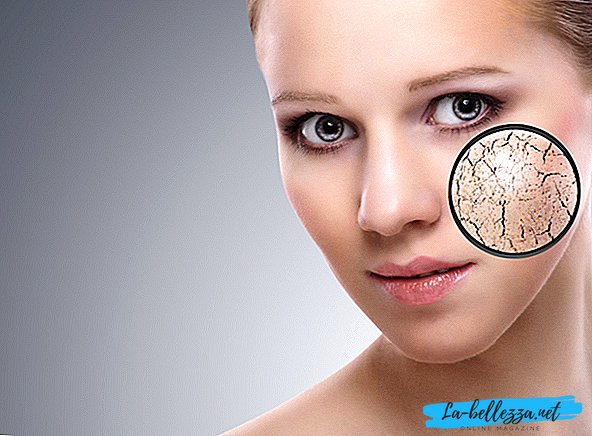
Peeling is a great way to refresh your skin and restore its lost radiance. But the girls who have decided on this procedure, know that at least a week after the cleaning will have to literally hide from prying eyes. The reason for this - a strong peeling of the skin.
Causes of skin peeling after peeling

Exfoliation (the second name for the procedure of deep cleansing of the skin) is the self-cleaning of the surface structure of the epidermis, which we call scaling. In other words, face peeling is inherently inseparable from the process of exfoliating the cells of the stratum corneum. But in some cases, the skin peels off from the face too intensely, which greatly worries those who have undergone the peeling procedure.
To determine the permissible intensity of post-peeling peeling, you should select it main reasons. These include factors such as:
- Intensity. Beauticians distinguish between three types of peeling: superficial, median and deep. The last two types imply an impact on the deeper layers of the epidermis, therefore, the skin is injured more intense. As a result, a few days after the peeling procedure, a strong peeling appears, accompanied by redness and swelling;
- The chemical composition of the peeling drug. The sparing types of exfoliative agents include alpha-hydroxy acids (malic, lactic, etc.) and enzyme preparations based on bromelain and papain. Such components rarely cause severe peeling. But the use of trichloroacetic acid can give intensive exfoliation;
- Individual features of the epidermis. As a rule, patients in whom the skin is distinguished by hypersensitivity and dryness, note in themselves excessive peeling after peeling.
Interesting fact: Retinoic or yellow peeling is one of the shortest rehabilitation periods. The consequences of its implementation become almost unnoticeable after 2 to 3 days. However, how many days the skin peels off after yellow peeling will largely depend on the patient's epidermis and its age.
How long does the skin peel off after peeling?
 Woman after deep chemical peeling (on the 5th day after the procedure)
Woman after deep chemical peeling (on the 5th day after the procedure)Many patients or patients who decide to undergo a peeling procedure are primarily interested in how much restoration will take and after what period the desired rejuvenation effect will be achieved.
It’s not possible to clearly determine on what day after peeling the peeling begins, however you can roughly calculate duration of the rehabilitation period in days, depending on the type of product used:
- For those who undergo a deep cleansing procedure for the first time, it is usually selected. surface peelingusing an exfoliative preparation with a minimum acid concentration. In this case, peeling of the skin occurs approximately on the third day, and the skin after peeling will peel off for another 2 to 3 days;
- If held median peeling, peeling intensity is higher, and the process will take about seven days;
- Deep exfoliation involves the most traumatic method of cleaning the face. Accordingly, the regeneration process after deep peeling will be the longest, peeling will last at least 10 - 15 days.
Effects of peeling

After exposure to chemical components that are used for superficial, middle or deep peeling, the skin gets a chemical burn. As a result, the top layer of the epidermis dies off and exfoliates. What we see is a process of exfoliation of the departed stratum corneum, lasting for several days or even weeks.
In parallel, the skin proceeds to self-recovery. The amount of collagen and elastin fibers increases, the "new" cells produced are lifted to the surface, replacing the old dead layer. At the same time, the skin of the face looks reddened, peeling appears on it, swelling and a sensation of intense burning / itching are possible. But all these phenomena after the procedure are considered absolutely normal.
Unfortunately, the consequences are not always limited to banal peeling. There are more serious side effects. TO atypical peeling reactions include the following symptoms:
- Hyperemia. Erythema (redness) is a typical reaction of a traumatic effect on the skin. However, if the red spots change shade, become more intense in color and do not disappear within the maximum time allowed after the peeling, you should consult a doctor;
- An exudative rash with a transparent or muddy, watery content is a direct signal of a severe thermal / chemical burn due to a violation of the peeling procedure technology and an excess of the peeling concentration. The unfortunate consequences are often scars and pigmented spots on the face;
- Allergic reaction in the form of severe edema of facial skin tissues, erythema and increase in local temperature. Usually appears in the first days after the procedure;
- Hyperpigmentation. It overtakes those who ignore the rules of skin care after cleaning and appear in the sun without first applying sunscreen cosmetics during the day;
- Scarring - the formation of residual scars and scars on the skin, is the result of mechanical damage to drying crusts on the face.
Most often, atypical reactions to peeling occur for three reasons, including improper selection of an exfoliative drug, silencing or late detection of unrecorded contraindications to the procedure and mistakes or ignoring compliance with the recommendations during the rehabilitation period during the first days after peeling.
Recommendations for skin care after peeling

The recovery period after the peeling procedure depends largely on how deeply the skin has been cleansed. Naturally, the appearance of anti-aging effect will have to wait. In addition, you must accept the temporary defects in appearance, among which appear:
- Moderate or severe erythema (redness and swelling) on the treated epithelium;
- Tightness and dryness of the skin;
- The sensation of burning and local temperature increase in the areas where the peeling was carried out;
- Intense peeling, the effects of which are visible to others;
- General discomfort (physical and emotional).
In order to properly care for the skin that has undergone such a traumatic process as peeling, you need to follow a strict regimen, which is in many ways close to inpatient treatment.
Facial care after peeling should include the following measures:
- The reduction of physical activity, the rejection of strength training - with a heavy load inevitably the release of sweat, and this is undesirable for the skin after exfoliation. In addition, with intense sports training there is a risk of mechanically damaging the face;
- During the recovery period after peeling (for 2 - 2.5 weeks) it is necessary to completely abandon the sauna, bath and swimming pool;
- Avoid foods with a high content of burning spices, spices and salt, as well as alcohol - their use increases the intensity of sweating;
- Smoking is not worth it. When you hold a cigarette in your mouth, you use the ring and other muscles of the mouth, and in the first days after peeling, you should minimize the facial expression. Nicotine use is generally undesirable;
- During the recovery period after peeling, it is necessary to refrain from visiting public institutions and events. You must protect yourself from potential sources of infection;
- It is necessary to observe the mode of rest and try not to be nervous. Under stress, the regenerative functions of the body significantly reduce their activity.
Even before the peeling procedure, be sure to ask your cosmetologist how to care for your face after a chemical peel. The reaction of each patient to a deep face cleansing is individual, as it depends on the state and characteristics of the organism.
Skin Care Tips in the Post-Procedure Period are universal and practically do not depend on how the type of peeling was carried out:
- Careful hydration of the skin is necessary;
- Injured by mechanical or chemical exposure to the skin has a tendency to hyperpigmentation when exposed to ultraviolet rays. That is why for the period of regeneration it is necessary to use sunscreen cosmetics;
- Reducing discomfort from peeling and tightness of the epidermis will help to remove products based on hyaluronate, thermal water, as well as products that contain vitamins B3 and pantothenic acid;
- Skin care during the recovery period, using creams and lotions on oily oil texture, is not recommended, as this can lead to the formation of comedones and the delay of peeling keratinocytes;
- Apply scrubs or gommazhi after cosmetology peeling is strictly prohibited. This drains and damages the thinned epidermis injured during the cleansing. In the worst case, there may be scars on the face.
Among other things, there are a number of prohibitions that must also be respected. It is strictly forbidden:
- Mechanically remove flakes that are separated after chemical attack on the stratum of skin. This again injures the skin and leads to the formation of scar tissue;
- Touch your face with untreated hands. So there is a high probability of infection in microtrauma left on the skin after peeling;
- Use decorative cosmetics. Care cosmetics are selected on an individual basis only after consultation and with the permission of a cosmetologist;
- To go out without applying sunscreen to the skin with a high protection factor (not lower than SPF +50);
- Wash with hard chlorinated water. During the first days it is better to wipe the eyelids and lips with wet cotton pads. For washing, take bottled water.
How to speed up the peeling process?

Dangling crusts and white cracked mesh of "dead" skin on the face do not give attractiveness even to the most beautiful ladies. To activate the peeling process and quickly bring the skin in order, you can use the following tips:
- Peeling is much faster if you apply moisturizing and regenerating preparations with antioxidants, hyaluronic acid, glycerin, urea, vitamins and nicotinic acid;
- If desquamation is accompanied by intense itching, use pharmaceutical preparations with a soothing and healing effect, which include panthenol and bisabolol. Boro plus cream has a good effect;
- With a pronounced inflammatory process, it is possible to use stronger pharmaceuticals, such as Levomekol ointment and hydrocortisone cream. Remember that you should use drugs with hydrocortisone only with a doctor's prescription.
Useful advice: if you are worried about a strong persistent desquamation, ask your beautician if you can undergo an additional peeling procedure using enzymes or lactic acid. In some situations, such a measure is considered acceptable in order to facilitate the exfoliation process.
Strong flaking is a typical reaction to the use of chemical peels. Exfoliation and the accompanying enhanced separation of dead skin particles of the stratum corneum of the skin indicate that the process of renewal of the epidermis and dermis has been launched.
The intensity of peeling is determined by many factors, among which the professionalism of a cosmetologist is not the last condition. Usually, the duration of the peeling process takes about 10 - 15 days, but if you feel that improvement does not occur, you should consult with a cosmetologist or a dermatologist.











